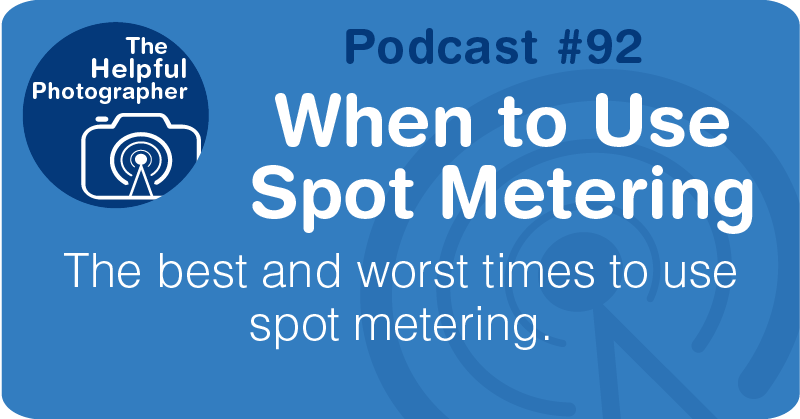When to Use Spot Metering #92
When to Use Spot Metering #92

As I explained in episode 59-61 metering is the system inside your camera that measures the light reflecting into it. Most cameras have several different options which determine how much of the frame it will measure, so the question is which option should you use?
Today I’m specifically going to talk about spot metering. There seems to be a persistent feeling in the blogosphere that spot metering is the superior option if you want to become a better photographer. So is it true that spot metering is superior? In my opinion no. Let me say it again, NO. Let me explain, spot metering works exactly the same way that wide area metering does just on much smaller area of the frame. So depending on your camera and also what the capabilities of that camera, it may not only be the right answer but the perfect answer. But it may also be the absolute wrong answer. Yes you heard that right, I said it can be the right answer and the wrong answer as well. The reason is because it completely depends on what you are shooting. So when is a good time to use spot metering? One of the perfect times to use spot metering in when your subject is small in your frame and is very different in density from the rest of the frame. To be clear, by small I mean a small portion of the frame. This is why bird photographers prefer to use spot metering. Very often that small bird is up against a background that will overwhelm the exposure, like the sky. In this instance the bird will render very very dark against that very bright sky. If you spot meter on the bird, then the bird will render as middle grey. I did not say that you will get a perfect over all exposure, I said that the bird will render as middle grey. And since most birds fall in the middle gray spectrum and it is your main subject this is what you’ll want. The fact is that there is a high probability that the sky will render extremely over exposed. The reason is because you are shooting a high contrast scene. The bird is very dark relative to the sky which is very bright. By metering on the bird itself the camera is upping the exposure to make that bird middle gray therefore making the entire scene brighter. By using spot metering you are telling the camera to do what it needs to do to make what it’s metering middle gray. So let’s say it’s a white crane. If you are metering off of the white body of that crane, you are telling the camera to make that white middle gray which means the entire scene will be darker to achieve that. On the other hand, if you are shooting and metering a black crow, you are telling the camera to make that black middle gray; to achieve that the exposure will have to go up rendering the entire scene brighter. Unless you can control the light, like in a studio setting, you are stuck with this. It just is what it is. The fact is that most bird photographers are ok with this because they want that bird perfect and since most birds are actually close to middle gray this works out well for them. If you find that your bird is significantly darker or lighter than middle gray as with the examples, you could simply exposure compensate to make up for this.
Having said all of this, recently a bird photographer was sharing his images with me and there were significant exposure problems on the bird despite the use of spot metering. So what happened and what did the image look like. First the bird was nearly black. Second it was flying high in the sky on a bright day. The bird was still a bit dark in the image likely because the metering wasn’t just centered on the bird but also overlapped the sky. But that wasn’t even the worst of the problems. Around the edges of the bird’s wings there were no sharp details. It looked really blown out. Imagine a really bad chromatic aberration problem. Chromatic aberrations are most apparent in hard contrasty edges. In this case the black wing of a bird against a very bright sky. The second issue is that the photographer was metering the dark bird. As the camera attempts to expose the dark bird as middle gray the rest of the photo is getting blown out. Remember it’s a sky in the middle of the day. And because the wings of the bird is catching more light, those areas become over exposed as well and therefore compounding the problem. What’s the solution? I’m sorry to say but the solution is to wait for better lighting. Better lighting can be had at different times of the day or simply waiting for the bird to swoop into a different area of the world with better light or an area where the background is not so bright relative to the bird. The bottom line is photographing moving objects, especially small moving objects isn’t easy and spot metering won’t solve all of your problems but it can definitely help.
Another group of photographers who might be able to capitalize on spot metering are portrait photographers because their subject is rather consistent. And here in the western world, the skin tone of most people fall in the middle gray range, usually plus or minus a stop. But what about people with darker skin tones? Simply exposure compensate a little bit darker to account for this. And for those who are more pale than middle gray you can just compensate to the other side, a little bit brighter. To be clear I’m talking about exposure problems not lighting problems. For a beautiful shot you will still need to light your subject properly. Metering is just there to make sure that the subject is properly exposed not properly lit.
Before I move on, I also want to talk about spot metering that tracks a focus point. In very few cameras, and trust me it’s very few cameras, you can set your metering so that it tracks where you put your focus point. The problem with this, especially for those who are shooting portraits, is that very often people are being told to make sure that the eyes is in focus. If you put that focus point on the model’s eyes and the model has dark eyes it’s going to skew your exposure if you have tracked your spot metering to that focus point. Do be aware of that. Moving on as you can see I’m talking about very specific situations where you would want to use spot metering. Short of this, I find that spot metering only causes problems for most photographers. If you are shooting a landscape or just general travel photography, anything from architecture to street photography use wide area metering – the widest you can possibly get out of your camera and then just exposure compensate to fine tune the exposure. You’ll find that most of the time you won’t need to do much at all and your exposures will be nearly perfect. I know there are those who would dispute this with me until both of us are blue, I actually had this conversation with one of our other photographers just last night and he was on the other end of this. But the fact is that most people don’t have enough experience or knowledge to capitalize on spot metering. Again, you can use it very effectively, but until you get a lot of images under your belt and understanding the function of your camera is second nature, spot metering will be tough tough hill to climb.











